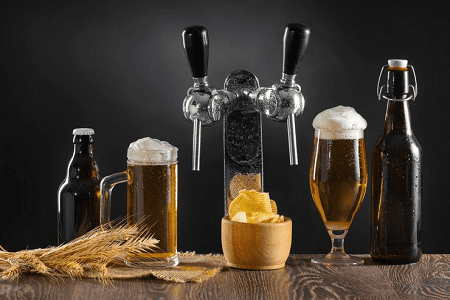Types of beer with examples and alcoholic percentage- Here are some of the most popular types of beers, along with some examples and their typical alcohol by volume (ABV):
- Lagers: Lagers are light-colored beers brewed with a cool-fermenting yeast strain. They are known for their crisp, clean flavor and refreshing taste.
- Pilsner (4.2% – 5.6% ABV): Pilsners are the original pale lagers, known for their hoppy bitterness and golden color.Opens in a new windowluekensliquors.com Pilsner beer
- American Lager (4.2% – 5.2% ABV): American lagers are lighter-bodied than Pilsners and often have a slightly sweet flavor. Popular examples include Budweiser and Coors Light.Opens in a new windowoysterbaybrewing.com American Lager beer
- Ales: Ales are brewed with a warm-fermenting yeast strain, which gives them a fruitier and more complex flavor than lagers.
- Pale Ale (4.5% – 7% ABV): Pale ales are golden-colored beers with a moderate hop bitterness. Popular examples include Sierra Nevada Pale Ale and Bass Pale Ale.Opens in a new windowsierranevada.com Pale Ale beer
- India Pale Ale (IPA) (5% – 14% ABV): IPAs are known for their intense hoppiness, which can range from floral to citrusy to piney. They can vary greatly in ABV. Some popular IPAs include Dogfish Head 60 Minute IPA and New England IPA (NEIPA) known for its juicier, fruitier taste.Opens in a new windowwww.britannica.com India Pale Ale (IPA) beer
- Wheat Beers: Wheat beers are light-bodied beers brewed with a significant amount of wheat malt. They are often cloudy in appearance and have a refreshing, slightly tart flavor.
- American Wheat Ale (3.5% – 5.6% ABV): American wheat ales are light and refreshing, with a hint of citrus or spice. Popular examples include Blue Moon Belgian White and Hoegaarden White.Opens in a new windowvinepair.com American Wheat Ale beer
- Hefeweizen (4.5% – 5.5% ABV): Hefeweizens are German wheat beers that are known for their banana and clove flavors.Opens in a new windowblackhorsebrews.com Hefeweizen beer
- Porters and Stouts: Porters and stouts are dark beers brewed with roasted malt. They have a rich, malty flavor and can range from dry to sweet.
- Porter (4.5% – 7% ABV): Porters are dark brown beers with a roasty flavor and a hint of chocolate or coffee. Popular examples include Guinness and Samuel Adams Boston Lager.Opens in a new windowwikipedia.org Porter beer
- Stout (5% – 12% ABV): Stouts are even darker than porters and have a more intense roasty flavor. Popular examples include Guinness Imperial Stout and Founders Breakfast Stout.Opens in a new windowen.wikipedia.org Stout beer
This is just a small sampling of the many different types of beers available. With so many varieties to choose from, there’s sure to be a beer out there for everyone. Remember to always drink responsibly!
What is Required Types of beer with examples and alcoholic percentage
Here are some of the most popular types of beers, along with some examples and their typical alcohol by volume (ABV):
- Lagers: Lagers are light-colored beers brewed with a cool-fermenting yeast strain. They are known for their crisp, clean flavor and refreshing taste.
- Pilsner (4.2% – 5.6% ABV): Pilsners are the original pale lagers, known for their hoppy bitterness and golden color.Opens in a new windowluekensliquors.com Pilsner beer
- American Lager (4.2% – 5.2% ABV): American lagers are lighter-bodied than Pilsners and often have a slightly sweet flavor. Popular examples include Budweiser and Coors Light.Opens in a new windowoysterbaybrewing.com American Lager beer
- Ales: Ales are brewed with a warm-fermenting yeast strain, which gives them a fruitier and more complex flavor than lagers.
- Pale Ale (4.5% – 7% ABV): Pale ales are golden-colored beers with a moderate hop bitterness. Popular examples include Sierra Nevada Pale Ale and Bass Pale Ale.Opens in a new windowsierranevada.com Pale Ale beer
- India Pale Ale (IPA) (5% – 14% ABV): IPAs are known for their intense hoppiness, which can range from floral to citrusy to piney. They can vary greatly in ABV. Some popular IPAs include Dogfish Head 60 Minute IPA and New England IPA (NEIPA) known for its juicier, fruitier taste.Opens in a new windowwww.britannica.com India Pale Ale (IPA) beer
- Wheat Beers: Wheat beers are light-bodied beers brewed with a significant amount of wheat malt. They are often cloudy in appearance and have a refreshing, slightly tart flavor.
- American Wheat Ale (3.5% – 5.6% ABV): American wheat ales are light and refreshing, with a hint of citrus or spice. Popular examples include Blue Moon Belgian White and Hoegaarden White.Opens in a new windowvinepair.com American Wheat Ale beer
- Hefeweizen (4.5% – 5.5% ABV): Hefeweizens are German wheat beers that are known for their banana and clove flavors.Opens in a new windowblackhorsebrews.com Hefeweizen beer
- Porters and Stouts: Porters and stouts are dark beers brewed with roasted malt. They have a rich, malty flavor and can range from dry to sweet.
- Porter (4.5% – 7% ABV): Porters are dark brown beers with a roasty flavor and a hint of chocolate or coffee. Popular examples include Guinness and Samuel Adams Boston Lager.Opens in a new windowwikipedia.org Porter beer
- Stout (5% – 12% ABV): Stouts are even darker than porters and have a more intense roasty flavor. Popular examples include Guinness Imperial Stout and Founders Breakfast Stout.Opens in a new windowen.wikipedia.org Stout beer
This is just a small sampling of the many different types of beers available. With so many varieties to choose from, there’s sure to be a beer out there for everyone. Remember to always drink responsibly!
Who is Required Types of beer with examples and alcoholic percentage
There isn’t a single required type of beer. Beer comes in a vast array of styles and flavors, and what someone drinks depends entirely on their taste preference. My previous response offered some of the most popular types of beers to give you a general idea of the variety available.
Here’s another way to look at it: there are no required foods either! People choose what they enjoy eating. Beer is similar – it’s about finding what you like based on factors like:
- Color: Lagers tend to be pale, while stouts are dark.
- Flavor: Some beers are hoppy (bitter), others are malty (sweet), and some have fruity or spicy notes.
- Alcohol Content: This can range from low-alcohol beers (around 3%) to high-alcohol varieties (over 10%).
So, the next time you’re looking for a beer, explore different styles to find your favorites!
When is Required Types of beer with examples and alcoholic percentage

There isn’t a specific situation where knowing the types of beers with their examples and alcohol percentage is required. However, this information can be helpful in a few circumstances:
- Ordering a beer: Understanding different beer styles and their characteristics can help you choose a beer you’ll enjoy at a restaurant or bar. Knowing the ABV can also help you pace yourself and drink responsibly.
- Trying new beers: If you’re unfamiliar with craft beers, this information can be a jumping-off point to explore different styles and find ones you like.
- Planning a party: When selecting beers for a gathering, having a variety of styles with a range of ABV options can cater to different preferences.
Overall, while not required, knowledge of beer styles and their alcohol content is empowering for making informed choices and having a more enjoyable beer experience.
Where is Required Types of beer with examples and alcoholic percentage
There isn’t a single place where knowing the types of beers with their examples and alcohol percentage is mandatory. It’s more about personal preference and specific situations. However, this knowledge can be very handy in a few settings:
- Liquor stores: Many stores have a vast selection of beers, and browsing by style and ABV can help you navigate the options and find what you’re looking for.
- Beer menus at restaurants or bars: Descriptions might be limited, so understanding beer styles beforehand can help you decipher the menu and choose something you’ll enjoy.
- Conversations about beer: If you’re talking to friends or colleagues who are into beer, knowing the basics can help you participate in the conversation and maybe even discover new favorites.
Overall, while not a requirement, having this knowledge is like having a cheat sheet for navigating the world of beer and making informed choices for your taste and the situation.
How is Required Types of beer with examples and alcoholic percentage
There isn’t really a situation where knowing the types of beers with their examples and alcohol percentage is absolutely required. Beer is a beverage enjoyed for pleasure, and the choice of what to drink is a personal one.
However, this information can be incredibly useful in several ways:
- Making informed choices: When faced with a long list of beers at a bar or browsing a large selection in a store, understanding the different styles and their characteristics allows you to pick a beer you’ll likely enjoy based on your taste preferences. The ABV (alcohol by volume) is also important for responsible drinking, as you can pace yourself based on the strength of the beer.
- Exploring new beers: If you’re new to craft beers or simply want to try something different, knowing some basic styles acts as a jumping-off point. You can then choose styles that sound appealing and discover new favorites.
- Planning and hosting: If you’re planning a party or get-together where beer will be served, knowing different styles and their ABV range allows you to offer a variety that caters to diverse preferences. You can ensure there’s something for everyone, from those who enjoy lighter options to those who prefer something bolder.
- Engaging in conversations: If you’re around people who enjoy beer, having a basic understanding allows you to participate in conversations and maybe even learn about new styles you haven’t tried before.
In essence, knowing the different types of beers, some examples, and their alcohol content is like having a cheat sheet for the world of beer. It empowers you to make informed choices, explore new tastes responsibly, and participate in conversations about this popular beverage.
Case Study on Types of beer with examples and alcoholic percentage
Understanding Beer Styles for Informed Consumption
Introduction:
Beer is one of the world’s most popular alcoholic beverages, with a vast array of styles offering a wide range of flavors and alcohol content (ABV). This case study explores the different types of beers, providing examples and their typical ABV, to empower consumers to make informed choices based on their preferences.
Target Audience:
- Beer enthusiasts looking to expand their knowledge of different styles.
- Newcomers to craft beer seeking a basic understanding of options.
- Individuals planning social gatherings where beer will be served.
Objectives:
- Identify and categorize major beer styles based on brewing methods and ingredients.
- Provide examples of popular beers within each style category.
- Explain the typical ABV range for each style.
- Demonstrate how knowledge of beer styles empowers informed consumption.
Methodology:
- Research and compile information on primary beer styles (e.g., Lagers, Ales, Wheat Beers, Porters & Stouts).
- Select representative examples of popular beers within each style.
- Analyze the ABV range for each style category.
- Develop a clear and concise presentation of findings.
Findings:
- Lagers: Light-colored beers brewed with cool-fermenting yeast. Known for their crisp, clean flavor and refreshing taste.
- Examples: Pilsner (4.2% – 5.6% ABV), American Lager (4.2% – 5.2% ABV) – Budweiser, Coors Light.
- Ales: Fruitier and more complex flavor compared to lagers due to warm-fermenting yeast.
- Examples: Pale Ale (4.5% – 7% ABV) – Sierra Nevada Pale Ale, India Pale Ale (IPA) (5% – 14% ABV) – Dogfish Head 60 Minute IPA, New England IPA (NEIPA).
- Wheat Beers: Light-bodied with a refreshing, slightly tart flavor due to a significant amount of wheat malt. Often cloudy in appearance.
- Examples: American Wheat Ale (3.5% – 5.6% ABV) – Blue Moon Belgian White, Hefeweizen (4.5% – 5.5% ABV).
- Porters & Stouts: Dark beers brewed with roasted malt, offering a rich, malty flavor that can range from dry to sweet.
- Examples: Porter (4.5% – 7% ABV) – Guinness, Stout (5% – 12% ABV) – Guinness Imperial Stout.
Benefits of Understanding Beer Styles:
- Matching taste preferences: Choosing a beer style that aligns with your preferred flavor profile (e.g., hoppy, malty, light, dark).
- Responsible drinking: Knowing the ABV allows for responsible consumption by pacing yourself based on the beer’s strength.
- Exploring new beers: Using styles as a starting point to discover new and exciting flavors within the vast world of beer.
- Engaging in beer conversations: Having a basic understanding allows you to participate in discussions about beer and potentially learn about new styles.
- Planning social gatherings: Offering a variety of styles with different ABV options caters to diverse preferences of your guests.
Conclusion:
Understanding beer styles empowers informed consumption, allowing you to navigate the vast selection with confidence. By knowing the characteristics of each style, along with examples and their typical ABV, you can choose beers that suit your taste, explore new options responsibly, and enhance your overall beer experience.
White paper on Types of beer with examples and alcoholic percentage
Abstract:
This white paper explores the diverse landscape of beer styles, equipping readers with the knowledge to navigate breweries, bottle shops, and beer menus with confidence. It outlines the main categories of beer, provides popular examples within each style, and details their typical alcohol by volume (ABV) range.
Introduction:
Beer, a historical and cultural beverage enjoyed worldwide, boasts an impressive array of styles catering to various palates. From light and crisp lagers to complex and flavorful ales, understanding these styles empowers informed choices and a more enjoyable beer experience.
Categorizing Beer Styles:
The two main categories of beer are distinguished by the yeast strain used in fermentation:
- Lagers: Brewed with cool-fermenting yeast strains, resulting in clean, crisp, and refreshing beers.
- Examples:
- Pilsner (4.2% – 5.6% ABV): Known for its hoppy bitterness and golden color.
- American Lager (4.2% – 5.2% ABV): Lighter-bodied with a slightly sweet flavor. (e.g., Budweiser, Coors Light)
- Examples:
- Ales: Utilize warm-fermenting yeast strains, producing beers with a wider range of flavors and aromas compared to lagers.
- Examples:
- Pale Ale (4.5% – 7% ABV): Golden-colored with a moderate hop bitterness. (e.g., Sierra Nevada Pale Ale, Bass Pale Ale)
- India Pale Ale (IPA) (5% – 14% ABV): Renowned for intense hoppiness, ranging from floral to citrusy to piney. (e.g., Dogfish Head 60 Minute IPA)
- New England IPA (NEIPA): A sub-style known for its juicier, fruitier taste.
- Examples:
Beyond the Basics:
The world of beer extends far beyond these two main categories. Here’s a glimpse into some popular sub-styles:
- Wheat Beers: Light-bodied and refreshing with a slightly tart flavor due to a significant amount of wheat malt. Often cloudy in appearance. (e.g., American Wheat Ale (3.5% – 5.6% ABV) – Blue Moon Belgian White, Hefeweizen (4.5% – 5.5% ABV))
- Porters and Stouts: Dark beers brewed with roasted malt, offering a rich, malty flavor profile that can range from dry to sweet. (e.g., Porter (4.5% – 7% ABV) – Guinness, Stout (5% – 12% ABV) – Guinness Imperial Stout)
- Sour Beers: Characterized by a tart or acidic flavor profile achieved through various fermentation methods. (ABV varies)
Benefits of Understanding Beer Styles:
- Informed Choices: Matching your taste preferences to specific styles allows for a more enjoyable drinking experience. (e.g., hoppy vs. malty, light vs. dark)
- Responsible Consumption: Knowing the ABV helps with responsible drinking by pacing yourself based on the beer’s strength.
- Exploration: Using styles as a starting point for exploring new and exciting flavors within the vast world of craft beers.
- Engaging in Beer Conversations: Having a basic understanding allows you to participate in discussions about beer and potentially discover new styles.
- Planning Social Gatherings: Offering a variety of styles with different ABV options caters to diverse preferences of your guests.
Conclusion:
Understanding beer styles equips you to navigate the exciting world of beer with confidence. By knowing the characteristics of different styles, along with examples and their typical ABV, you can make informed choices, explore new options responsibly, and enhance your overall beer experience. Whether you’re a seasoned beer drinker or just starting your journey, this knowledge empowers you to discover a beer that perfectly suits your taste.
Further Exploration:
This white paper provides a foundational understanding of beer styles. For a deeper dive, consider exploring resources offered by brewers’ associations, beer review websites, and local breweries that often host educational events and tastings.
Industrial Application of Types of beer with examples and alcoholic percentage
While there isn’t a direct industrial application of beer styles in the traditional sense, there are some interesting ways breweries consider these factors during the production process:
Efficiency and Target Audience:
- Large-scale brewers: Producing mass-market beers often relies on lagers (e.g., American Lagers) due to:
- Cooler fermentation: Lager yeast ferments at lower temperatures, requiring less energy compared to warm-fermenting ales.
- Faster turnaround: Lagers have a shorter fermentation time, allowing for quicker production and higher output.
- Broad appeal: Lagers are known for their clean, crisp taste, making them widely popular and appealing to a general audience.
- Craft breweries: These breweries often experiment with various styles to cater to specific preferences and demographics.
- Fruity ales: Targeting a younger audience, these might have lower ABV (3.5% – 5%) and use fruit extracts or hops with citrusy or tropical aromas.
- High ABV beers: Geared towards craft beer enthusiasts, these could be strong ales or stouts (8% – 14% ABV) with complex flavors achieved through specific ingredients and brewing techniques.
Seasonal and Regional Influences:
- Summer beers: Lighter styles like wheat beers (American Wheat Ale) or Kölsch (pale ale style) with lower ABV (4% – 5.5%) are popular during warmer months due to their refreshing taste.
- Winter beers: Styles like stouts and porters (5% – 10% ABV) with richer, maltier profiles and a higher alcohol content are suited for colder seasons, offering a warming effect.
- Local ingredients: Breweries might use local fruits, grains, or spices to create unique beers that reflect the region’s character. For instance, a Belgian brewery might use local cherries in a sour beer recipe.
Waste Reduction and Sustainability:
- Spent grain: Leftover grain after brewing can be used as cattle feed or upcycled into other products like granola bars.
- This reduces waste and promotes resource efficiency.
It’s important to note that these are just some examples, and the brewing industry is constantly evolving. New technologies and consumer preferences can influence how breweries approach beer styles in an industrial setting.





